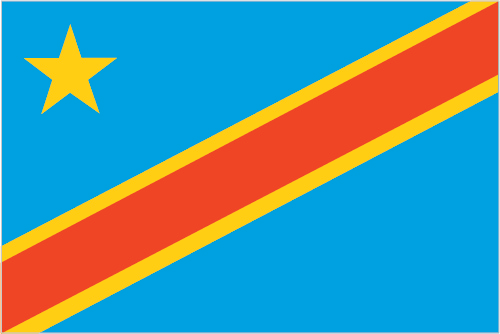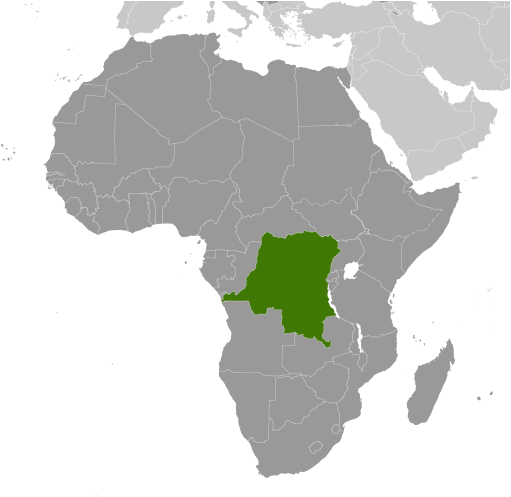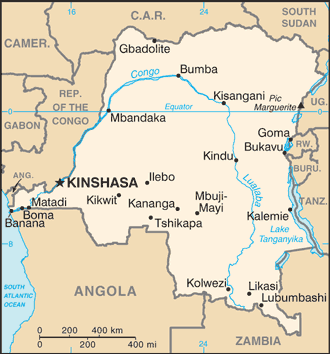|
Country name:
|

|
|
conventional long form: Democratic Republic of the Congo
conventional short form:
DRC
local long form:
Republique Democratique du Congo
local short form:
RDC
former:
Congo Free State, Belgian Congo, Congo/Leopoldville, Congo/Kinshasa, Zaire
abbreviation:
DRC
|
|
|
Government type:
|

|
|
republic
|
|
|
Capital:
|

|
|
name: Kinshasa
geographic coordinates:
4 19 S, 15 18 E
time difference:
UTC+1 (6 hours ahead of Washington, DC during Standard Time)
|
|
|
Administrative divisions:
|

|
|
10 provinces (provinces, singular - province) and 1 city* (ville); Bandundu, Bas-Congo (Lower Congo), Equateur, Kasai-Occidental (West Kasai), Kasai-Oriental (East Kasai), Katanga, Kinshasa*, Maniema, Nord-Kivu (North Kivu), Orientale, Sud-Kivu (South Kivu)
note:
according to the Constitution adopted in December 2005, the current administrative divisions were to be subdivided into 26 new provinces by 2009 but this has yet to be implemented
|
|
|
Independence:
|

|
|
30 June 1960 (from Belgium)
|
|
|
National holiday:
|

|
|
Independence Day, 30 June (1960)
|
|
|
Constitution:
|

|
|
18 February 2006
|
|
|
Legal system:
|

|
|
civil legal system based on Belgian version of French civil law
|
|
|
International law organization participation:
|

|
|
accepts compulsory ICJ jurisdiction with reservations; accepts ICCt jurisdiction
|
|
|
Suffrage:
|

|
|
18 years of age; universal and compulsory
|
|
|
Executive branch:
|

|
|
chief of state: President Joseph KABILA (since 17 January 2001)
head of government:
Prime Minister Augustin MATATA PONYO Mapon (since 18 April 2012)
cabinet:
Ministers of State appointed by the president
(For more information visit the World Leaders website  ) )
elections:
under the new constitution the president elected by popular vote for a five-year term (eligible for a second term); elections last held on 28 November 2011 (next to be held on November 2016); prime minister appointed by the president
election results:
Joseph KABILA reelected president; percent of vote - Joseph KABILA 49%, Etienne TSHISEKEDI 32.3%, other 18.7%; note - election marred by serious voting irregularities
note:
Joseph KABILA succeeded his father, Laurent Desire KABILA, following the latter's assassination in January 2001; negotiations with rebel leaders led to the establishment of a transitional government in July 2003 with free elections held on 30 July 2006 and a run-off on 29 October 2006 confirming Joseph KABILA as president
|
|
|
Legislative branch:
|

|
|
bicameral legislature consists of a Senate (108 seats; members elected by provincial assemblies to serve five-year terms) and a National Assembly (500 seats; 61 members elected by majority vote in single-member constituencies, 439 members elected by open list proportional-representation in multi-member constituencies to serve five-year terms)
elections:
Senate - last held on 19 January 2007 (next scheduled for 5 June 2013; though likely to be delayed); National Assembly - last held on 28 November 2011 (next to be held in 2016)
election results:
Senate - percent of vote by party - NA; seats by party - PPRD 22, MLC 14, FR 7, RCD 7, PDC 6, CDC 3, MSR 3, PALU 2, independents 26, others 18 (political parties that won a single seat); National Assembly - percent of vote by party - NA; seats by party - PPRD 62, UDPS 41, PPPD 29, MSR 27, MLC 22, PALU 19, UNC 17, ARC 16, AFDC 15, ECT 11, RRC 11, independents 16, others 214 (includes numerous political parties that won 10 or fewer seats and 2 constituencies where voting was halted); note - the November 2011 elections were married by violence including the destruction of ballots in two constituencies resulting in the closure of polling sites; election results were delayed three months, stongly contested, and continue to be unresolved
|
|
|
Judicial branch:
|

|
|
Constitutional Court; Appeals Court or Cour de Cassation; Council of State; High Military Court; plus civil and military courts and tribunals
|
|
|
Political parties and leaders:
|

|
|
Christian Democrat Party or PDC [Jose ENDUNDO]; Congolese Rally for Democracy or RCD [Azarias RUBERWA]; Convention of Christian Democrats or CDC; Forces of Renewal or FR [Mbusa NYAMWISI]; Movement for the Liberation of the Congo or MLC [Jean-Pierre BEMBA]; People's Party for Reconstruction and Democracy or PPRD [Joseph KABILA]; Social Movement for Renewal or MSR [Pierre LUMBI]; Unified Lumumbist Party or PALU [Antoine GIZENGA]; Union for the Congolese Nation or UNC [Vital KAMERHE]; Union for Democracy and Social Progress or UDPS [Etienne TSHISEKEDI]; Union of Mobutuist Democrats or UDEMO [MOBUTU Nzanga]
|
|
|
Political pressure groups and leaders:
|

|
|
FARDC (Forces Armées de la République Démocratique du Congo) - Army of the Democratic Republic of the Congo, which commits atrocities on citizens; FDLR (Forces Democratiques de Liberation du Rwanda) - Rwandan militia group made up of some of the perpetrators of Rwanda's Genocide in 1994; CNDP (National Congress for the Defense of the People) - mainly Congolese Tutsis who want refugees returned and more representation in government; M23 - rebel group comprised largely from ex-CNDP forces
|
|
|
International organization participation:
|

|
|
ACP, AfDB, AU, CEPGL, COMESA, EITI (candidate country), FAO, G-24, G-77, IAEA, IBRD, ICAO, ICRM, IDA, IFAD, IFC, IFRCS, IHO, ILO, IMF, IMO, Interpol, IOC, IOM, IPU, ISO, ITSO, ITU, ITUC (NGOs), MIGA, NAM, OIF, OPCW, PCA, SADC, UN, UNCTAD, UNESCO, UNHCR, UNIDO, UNWTO, UPU, WCO, WFTU (NGOs), WHO, WIPO, WMO, WTO
|
|
|
Diplomatic representation in the US:
|

|
|
chief of mission: Ambassador Faida Maramuke MITIFU
chancery:
Suite 601, 1726 M Street, NW, Washington, DC, 20036
telephone:
[1] (202) 234-7690 through 7691
FAX:
[1] (202) 234-2609
consulate(s) general:
New York
|
|
|
Diplomatic representation from the US:
|

|
|
chief of mission: Ambassador James F. ENTWISTLE
embassy:
310 Avenue des Aviateurs, Kinshasa
mailing address:
Unit 2220, DPO AE 09828
telephone:
[243] (081) 556-0151
FAX:
[243] (081) 556-0175
|
|
|
Flag description:
|

|
|
sky blue field divided diagonally from the lower hoist corner to upper fly corner by a red stripe bordered by two narrow yellow stripes; a yellow, five-pointed star appears in the upper hoist corner; blue represents peace and hope, red the blood of the country's martyrs, and yellow the country's wealth and prosperity; the star symbolizes unity and the brilliant future for the country
|
|
|
National symbol(s):
|

|
|
leopard
|
|
|
National anthem:
|

|
|
name: "Debout Congolaise" (Arise Congolese)
lyrics/music:
Joseph LUTUMBA/Simon-Pierre BOKA di Mpasi Londi
note:
adopted 1960; the anthem was replaced during the period in which the country was known as Zaire, but was readopted in 1997
|
|
|
|
|





 )
)



